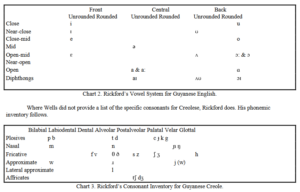Guyana formerly known as British Guiana obtained its independence from the United Kingdom in 1966; it became a republic in 1970. The Republic of Guyana is North-East of South America. It is bordered by Suriname, Brazil and Venezuela. Guiana was originally inhabited by the Arawaks and Caribs. It was divided by European powers into Spanish Guiana (Venezuela), Portuguese Guiana (Brazil), French Guiana, Dutch Guiana (Suriname) and British Guiana (Guyana). Guyanese Creole is the de facto language in Guyana, with about 700,000 inhabitants speaking it according to the 2012 census. Guyanese Creole is an English based creole widely spoken by people who are natives of Guyana. Although many people speak Guyanese Creole, the official language of Guyana is English. Guyana is the only English-speaking country in South America. There are many sub-dialects of Guyanese Creole which exists based on a native’s geographical location, race and ethnicity. People in Guyana also speak Hindi, Urdu and Amerindian languages. Some of the most common dialects of Guyana include Afro-Guyanese Creole, Rupununi, and Indo-Guyanese Creole. According to the Guyana chronicle, along the Rupununi River where the population is largely Amerindian, a distinct form of Guyanese Creole exists. Rupununi dialect is said to be its own separate language. The capital city of Guyana is Georgetown. The dialect/accent changes where rural villages are located. The language traces back from the first African slaves who were brought to Guyana from different tribes. After contact with their slave masters they developed a pidgin to communicate with each other. When they arrived in Guyana they added words and expressions from their Dutch masters and over time this “Dutch-creole went through changes. A creole continuum exists between Guyanese English and Standard British English. Members of the upper class’s speech tend to phonetically be closest to the “Queen’s English”, whereas people who are from lower socioeconomic background their speech are closest to Caribbean English dialects. In Guyanese Creole, adjectives and adverbs are repeated for emphasis. There are many large parts of Guyana that are Forested Highland Region in the southern part of the country. Ninety percent of the inhabitants of Guyana live in the narrow, fertile plain along the Atlantic coast to the east of the country.
References:
“The rich cultural expression of Guyanese Creolese” Guyana Chronicle. Retrieved March 07, 2018 from http://guyanachronicle.com/2013/10/13/the-rich-cultural-expression-of-guyanese-creolese
“Guyana” The Commonwealth Heads of Government. Retrieved March 06, 2018 from https://thecommonwealth.org/our-member-countries/guyana
“Guyana” One World Nations Online. Retrieved March 05, 2018 from http://www.nationsonline.org/oneworld/guyana.htm
“Guyanese Creole English” Ethnologue languages of the world. Retrieved March 05, 2018 from https://www.ethnologue.com/language/gyn


